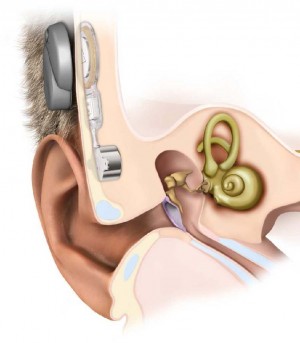Bonebridge, the world’s first active bone conduction implant system, is a revolutionary technology for patients with impaired hearing.
Patient Đ.H.Q., 48, HCMC, suffered profound hearing loss in his right ear when he was a child. Over the years, this problem has significantly impaired his quality of life. Mr. Q. visited FV Hospital to meet with Head of ORL Dr. Nguyen Quang Dai, who gave him a careful examination and concluded that Mr. Q was suffering from a Mondini malformation, a congenital condition reported the first time by Carlo Mondini in 1791 and which has clinical symptoms of serious or profound hearing loss. A CT scan result showed abnormalities in Mr. Q’s ear anatomy – his cochlear modiolus was missing, and his vestibule and vestibule passage was loose. Dr. Dai decided to give Mr. Q a Bonebridge implant. Four weeks after the surgery, Mr. Q’s right ear could process sound again, making him the first person in Vietnam to successfully undergo Bonebridge implant surgery.
Dr. Dai said: “Before, a Bone Anchored Hearing Aid (BAHA) was normally recommended for cases such as Mr. Q.’s. However, in a tropical climate, such as that found in Vietnam, Bonebridge is the best treatment option currently available as the device is implanted completely beneath the skin, making post-surgical care easier.”
Bonebridge is a modern bone conduction implant system installed under the skin which transmits sound that enters the ear through the bone. The Bonebridge system consists of two parts:
- An internal hearing implant placed under the skin which conducts processed sound waves to the bones. This implant holds the external processor in place above the implant by magnetic attraction.
- The external processor is held on the head by magnetic attraction and can be worn comfortably and invisibly under the hair.

The external processor receives sound and converts it into signal that is transmitted through the skin to the internal implant, which then converts the signal into vibrations transmitted to the inner ear. The quality of sound perceived in a Bonebridge implant system is superior compared to a conventional bone conduction hearing aid.
A Bonebridge implant is a simple procedure that takes around 30 minutes to one hour to complete. During this procedure, an incision is made behind the ear. The titanium fixture is then anchored on the bone of the skull behind the ear using screws. As the sound processor is positioned in place, the bone conduction system is also fixed to the bone of the skull by screws. Finally, the skin incision is closed with absorbable stitches. The surgery is performed on an outpatient basis.
A Bonebridge implant can be used as soon as the bruising and swelling of the skin area above the implant has gone. This means Bonebridge can be activated in two to four weeks following surgery. The Bonebridge system is recommended for patients with conductive hearing loss (hearing impairment due to abnormalities in ear canal, eardrum or middle ear) and mixed hearing loss (hearing impairment due to injuries in external ear, middle ear and inner ear) or single-sided deafness. Bonebridge is only recommended for patients 18 years old and above.
For individuals with conductive or mixed hearing loss, Bonebridge can overcome a loss of hearing in the middle ear by stimulating nerves directly. For individuals with single-sided deafness, Bonebridge can transfer sound from the poorer hearing ear to the better hearing ear.
A Bonebridge implant has a shorter recovery time and minimised infection risk when compared with other hearing aids. It is also convenient and easy to use, and ultimately offers patients an excellent treatment outcome.



